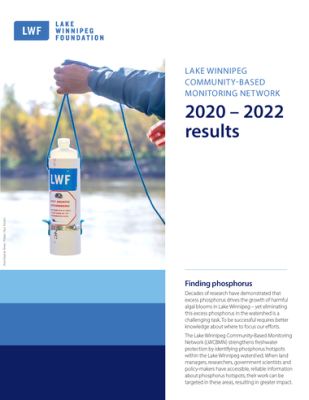
data for decision-making
The Lake Winnipeg Community-Based Monitoring Network (LWCBMN) is generating valuable data that can identify phosphorus hotspots. However, to meaningfully address eutrophication and protect Lake Winnipeg, data must not only be collected: it must also be used.
We are committed to sharing LWCBMN data in an open, accessible way. Our goal is to support evidence-based policy and practices by providing information about where the phosphorus affecting Lake Winnipeg is coming from.
identifying trends, sharing lessons
Our collective efforts are providing important answers – and raising new questions. After each LWCBMN field season, larger-scale phosphorus hotspot maps and interannual data trends are generated to share key lessons we are learning through our efforts.

LWCBMN 2020 – 2022 Results
Results from LWCBMN's 2020, 2021 and 2022 field seasons show recurring phosphorus hotspots. With seven years of data now in hand, LWCBMN points the way to evidence-based solutions for Lake Winnipeg.

LWCBMN 2019 Network Report
Our 2019 network report highlights the value of long-term monitoring, shares information on why we focus on phosphorus, and explores how climate change may influence the future of phosphorus loading.

LWCBMN 2018 Network Report
Our 2018 network report confirms the existence of phosphorus hotspots, highlights the importance of frequent and responsive sampling, and explains how storing water on the land can protect Lake Winnipeg.
Note: The 2019 LWCBMN network report includes information about apparent hotspots occurring along the Winnipeg River. After reviewing our data and consulting with our science advisors, we have removed water samples collected at hydroelectric generating stations from our dataset. Read more on our website about how we reached this decision, and how we are continuing to work with our partners to generate credible, useful data to enrich our understanding of phosphorus loading and point the way to collaborative solutions.
open-access data

Lake Winnipeg DataStream is an open-access online portal for sharing water-quality data. Launched in 2019 in collaboration with LWF, it’s part of a national DataStream network developed and led by The Gordon Foundation.
Designed to be intuitive and easy to use, Lake Winnipeg DataStream features searchable maps and other visualization tools. All data shared are standardized and comparable, making it easy to track trends. Users can select and download a range of water-quality data collected by community-based monitoring groups, governments, watershed organizations and researchers: from individual datapoints from a specific location on a specific date to entire datasets generated over years.
> explore LWCBMN phosphorus data and more on Lake Winnipeg DataStream
Realizing the Full Potential of Community-Based Monitoring
Our federal policy brief highlights how phosphorus data generated by the Lake Winnipeg Community-Based Monitoring Network (LWCBMN) can support regional decision-making and funding allocation, and urges any renewed federal program to explicitly recognize the value of LWCBMN data in order to effectively complete the data-to-impact cycle.
